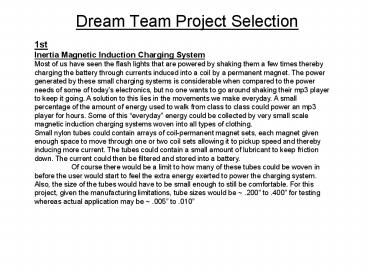Dream Team Project Selection PowerPoint PPT Presentation
1 / 5
Title: Dream Team Project Selection
1
- Dream Team Project Selection
1st Inertia Magnetic Induction Charging
System Most of us have seen the flash lights that
are powered by shaking them a few times thereby
charging the battery through currents induced
into a coil by a permanent magnet. The power
generated by these small charging systems is
considerable when compared to the power needs of
some of todays electronics, but no one wants to
go around shaking their mp3 player to keep it
going. A solution to this lies in the movements
we make everyday. A small percentage of the
amount of energy used to walk from class to class
could power an mp3 player for hours. Some of this
everyday energy could be collected by very
small scale magnetic induction charging systems
woven into all types of clothing. Small nylon
tubes could contain arrays of coil-permanent
magnet sets, each magnet given enough space to
move through one or two coil sets allowing it to
pickup speed and thereby inducing more current.
The tubes could contain a small amount of
lubricant to keep friction down. The current
could then be filtered and stored into a
battery. Of course there would be a limit to how
many of these tubes could be woven in before the
user would start to feel the extra energy exerted
to power the charging system. Also, the size of
the tubes would have to be small enough to still
be comfortable. For this project, given the
manufacturing limitations, tube sizes would be
.200 to .400 for testing whereas actual
application may be .005 to .010
2
2nd Smart Lights A vast amount of energy is
wasted each year by household overhead lighting.
A solution to this would be a smart lighting
system where overhead lights would track a person
around the room using a single light as well as
where the person was going using a separate
light. Once a person walks out of the light
systems range, the lights turn off and possibly
could send a signal to another set of lights
corresponding to where the person was heading.
Fewer total lights would be needed to provide the
same overall lighting by standard lights and the
amount of wasted electrical power would be
lowered. 3rd Handi-Brush The Handi-Brush is a
toothbrush for individuals with limited mobility
that makes the dental cleansing process less of a
hassle. It will be attached to the individuals
sink and be capable of moving in all directions
to allow for easy access. This device will also
be automatically loaded with toothpaste and have
a 360º bristle design to allow for easy usage by
any individual.
3
4th Small Running Humanoid Robot Most modern
walking robots move very slowly compared with the
running speed of the average person. This is due
to the difficulty of creating a control system to
handle the whole process. However, if the
movements could be directed by a simplified
controller that used partially closed-loop and
mostly open-loop control, the task of running may
not be so difficult to achieve. 5th Automated
Leaf Raker One of the annoying outdoor tasks that
many people have to deal with is raking their
yards. To make this task easier a solution is
developing an outdoor unmanned automated rake and
vacuum. The idea and functionality of this device
would be similar to the operation of the smart
vacuum.
4
6th Stay-Dry Umbrella for Automobiles The
Stay-Dry Umbrella is a mechanism that attaches to
any automobile that allows the driver to get in
and out of the car without getting wet on a rainy
day. It includes a trigger in the inside of the
car that causes the umbrella to deploy and then
once the driver has exited the car the umbrella
can then be detached from the housing on the
mechanism and used like a regular
umbrella. 7th Continuously Adjustable Damper
System Most spring-damper systems utilize a
dampener that is sometimes adjustable, however
the dampener either has to be taken apart and
revalved or its operation stopped while an
adjusting screw is turned to increase or decrease
its damping characteristics. A solution to this
would be to create a dampener whose valve plate
cut-out area was adjustable during operation by
changing its rotation through electromagnetic
windings much like that of a stepper motor. The
valve would actually consist of two plates with
cut-outs along half the edge of each plate.
During full damping the cut-outs would be 180
degrees apart. If less damping is desired, one
plates cut-out area could be rotated via the
stepper windings towards the cut-out area of
the stationary plate. If enough windings are
used, a seemingly continuous variance in damping
characteristics could be achieved.
5
8th Speak and Splash Voice activated shower
apparatus for people with upper extremity
disabilities.It has default temperature settings
and the person may adjust the water temperature
by saying "hotter" or "colder," depending on
their preference.

